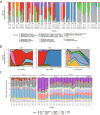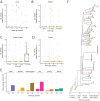Longitudinal quantification of Bifidobacterium longum subsp. infantis reveals late colonization in the infant gut independent of maternal milk HMO composition
- PMID: 38291346
- PMCID: PMC10827747
- DOI: 10.1038/s41467-024-45209-y
Longitudinal quantification of Bifidobacterium longum subsp. infantis reveals late colonization in the infant gut independent of maternal milk HMO composition
Abstract
Breast milk contains human milk oligosaccharides (HMOs) that cannot be digested by infants, yet nourish their developing gut microbiome. While Bifidobacterium are the best-known utilizers of individual HMOs, a longitudinal study examining the evolving microbial community at high-resolution coupled with mothers' milk HMO composition is lacking. Here, we developed a high-throughput method to quantify Bifidobacterium longum subsp. infantis (BL. infantis), a proficient HMO-utilizer, and applied it to a longitudinal cohort consisting of 21 mother-infant dyads. We observed substantial changes in the infant gut microbiome over the course of several months, while the HMO composition in mothers' milk remained relatively stable. Although Bifidobacterium species significantly influenced sample variation, no specific HMOs correlated with Bifidobacterium species abundance. Surprisingly, we found that BL. infantis colonization began late in the breastfeeding period both in our cohort and in other geographic locations, highlighting the importance of focusing on BL. infantis dynamics in the infant gut.
© 2024. The Author(s).
Conflict of interest statement
The authors declare no competing interests.
Figures






Similar articles
-
Priority effects, nutrition and milk glycan-metabolic potential drive Bifidobacterium longum subspecies dynamics in the infant gut microbiome.PeerJ. 2025 Jan 21;13:e18602. doi: 10.7717/peerj.18602. eCollection 2025. PeerJ. 2025. PMID: 39866568 Free PMC article.
-
Human milk oligosaccharides modify the strength of priority effects in the Bifidobacterium community assembly during infancy.ISME J. 2023 Dec;17(12):2452-2457. doi: 10.1038/s41396-023-01525-7. Epub 2023 Oct 10. ISME J. 2023. PMID: 37816852 Free PMC article.
-
tuf Gene Sequence Variation in Bifidobacterium longum subsp. infantis Detected in the Fecal Microbiota of Chinese Infants.Appl Environ Microbiol. 2018 Jun 18;84(13):e00336-18. doi: 10.1128/AEM.00336-18. Print 2018 Jul 1. Appl Environ Microbiol. 2018. PMID: 29703739 Free PMC article.
-
Probiotics in the New Era of Human Milk Oligosaccharides (HMOs): HMO Utilization and Beneficial Effects of Bifidobacterium longum subsp. infantis M-63 on Infant Health.Microorganisms. 2024 May 17;12(5):1014. doi: 10.3390/microorganisms12051014. Microorganisms. 2024. PMID: 38792843 Free PMC article. Review.
-
Human milk oligosaccharides combine with Bifidobacterium longum to form the "golden shield" of the infant intestine: metabolic strategies, health effects, and mechanisms of action.Gut Microbes. 2024 Jan-Dec;16(1):2430418. doi: 10.1080/19490976.2024.2430418. Epub 2024 Nov 21. Gut Microbes. 2024. PMID: 39572856 Free PMC article. Review.
Cited by
-
Priority effects, nutrition and milk glycan-metabolic potential drive Bifidobacterium longum subspecies dynamics in the infant gut microbiome.PeerJ. 2025 Jan 21;13:e18602. doi: 10.7717/peerj.18602. eCollection 2025. PeerJ. 2025. PMID: 39866568 Free PMC article.
-
The interplay between diet and the gut microbiome: implications for health and disease.Nat Rev Microbiol. 2024 Nov;22(11):671-686. doi: 10.1038/s41579-024-01068-4. Epub 2024 Jul 15. Nat Rev Microbiol. 2024. PMID: 39009882 Review.
-
Primary succession of Bifidobacteria drives pathogen resistance in neonatal microbiota assembly.Nat Microbiol. 2024 Oct;9(10):2570-2582. doi: 10.1038/s41564-024-01804-9. Epub 2024 Sep 6. Nat Microbiol. 2024. PMID: 39242817 Free PMC article.
-
Bifidobacterium deficit in United States infants drives prevalent gut dysbiosis.Commun Biol. 2025 Jun 24;8(1):867. doi: 10.1038/s42003-025-08274-7. Commun Biol. 2025. PMID: 40555747 Free PMC article.
-
Human DNA levels in feces reflect gut inflammation and associate with presence of gut species in IBD patients across the age spectrum.Res Sq [Preprint]. 2025 Jul 7:rs.3.rs-6809327. doi: 10.21203/rs.3.rs-6809327/v1. Res Sq. 2025. PMID: 40671808 Free PMC article. Preprint.
References
MeSH terms
Substances
Grants and funding
LinkOut - more resources
Full Text Sources

